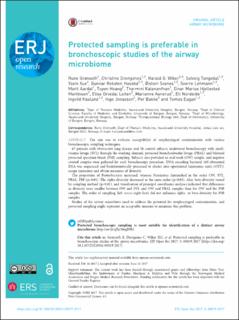| dc.contributor.author | Grønseth, Rune | |
| dc.contributor.author | Drengenes, Christine | |
| dc.contributor.author | Wiker, Harald G | |
| dc.contributor.author | Tangedal, Solveig | |
| dc.contributor.author | Xue, Yaxin | |
| dc.contributor.author | Husebø, Gunnar | |
| dc.contributor.author | Svanes, Øistein | |
| dc.contributor.author | Lehmann, Sverre | |
| dc.contributor.author | Aardal, Marit Elisabeth | |
| dc.contributor.author | Hoang, Tuyen | |
| dc.contributor.author | Kalananthan, Tharmini | |
| dc.contributor.author | Martinsen, Einar Marius Hjellestad | |
| dc.contributor.author | Leiten, Elise Orvedal | |
| dc.contributor.author | Aanerud, Marianne | |
| dc.contributor.author | Nordeide, Eli | |
| dc.contributor.author | Haaland, Ingvild | |
| dc.contributor.author | Jonassen, Inge | |
| dc.contributor.author | Bakke, Per S. | |
| dc.contributor.author | Eagan, Tomas Mikal | |
| dc.date.accessioned | 2021-07-07T14:01:54Z | |
| dc.date.available | 2021-07-07T14:01:54Z | |
| dc.date.created | 2019-04-11T15:43:17Z | |
| dc.date.issued | 2017 | |
| dc.identifier.issn | 2312-0541 | |
| dc.identifier.uri | https://hdl.handle.net/11250/2763834 | |
| dc.description.abstract | The aim was to evaluate susceptibility of oropharyngeal contamination with various bronchoscopic sampling techniques.
67 patients with obstructive lung disease and 58 control subjects underwent bronchoscopy with small-volume lavage (SVL) through the working channel, protected bronchoalveolar lavage (PBAL) and bilateral protected specimen brush (PSB) sampling. Subjects also provided an oral wash (OW) sample, and negative control samples were gathered for each bronchoscopy procedure. DNA encoding bacterial 16S ribosomal RNA was sequenced and bioinformatically processed to cluster into operational taxonomic units (OTU), assign taxonomy and obtain measures of diversity.
The proportion of Proteobacteria increased, whereas Firmicutes diminished in the order OW, SVL, PBAL, PSB (p<0.01). The alpha-diversity decreased in the same order (p<0.01). Also, beta-diversity varied by sampling method (p<0.01), and visualisation of principal coordinates analyses indicated that differences in diversity were smaller between OW and SVL and OW and PBAL samples than for OW and the PSB samples. The order of sampling (left versus right first) did not influence alpha- or beta-diversity for PSB samples.
Studies of the airway microbiota need to address the potential for oropharyngeal contamination, and protected sampling might represent an acceptable measure to minimise this problem. | en_US |
| dc.language.iso | eng | en_US |
| dc.publisher | European Respiratory Society | en_US |
| dc.rights | Navngivelse-Ikkekommersiell 4.0 Internasjonal | * |
| dc.rights.uri | http://creativecommons.org/licenses/by-nc/4.0/deed.no | * |
| dc.title | Protected sampling is preferable in bronchoscopic studies of the airway microbiome | en_US |
| dc.type | Journal article | en_US |
| dc.type | Peer reviewed | en_US |
| dc.description.version | publishedVersion | en_US |
| dc.rights.holder | Copyright 2017 ERS. | en_US |
| dc.source.articlenumber | 00019-2017 | en_US |
| cristin.ispublished | true | |
| cristin.fulltext | original | |
| cristin.qualitycode | 1 | |
| dc.identifier.doi | 10.1183/23120541.00019-2017 | |
| dc.identifier.cristin | 1691777 | |
| dc.source.journal | European Respiratory Journal Open Research (ERJ Open Research) | en_US |
| dc.identifier.citation | European Respiratory Journal Open Research. 2017, 3 (3), 00019-2017 | en_US |
| dc.source.volume | 3 | en_US |
| dc.source.issue | 3 | en_US |

